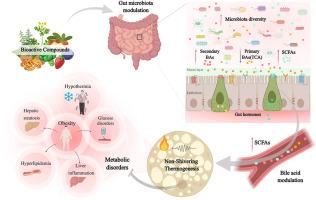Stimulation of non-shivering thermogenesis by bioactive compounds: A focus on gut microbiota-mediated mechanisms
IF 15.1
1区 农林科学
Q1 FOOD SCIENCE & TECHNOLOGY
引用次数: 0
Abstract
Background
Non-shivering thermogenesis (NST), an essential mechanism for heat generation without shivering, primarily involves brown and beige fats. This process enhances thermal comfort and holds the potential for combating obesity and its metabolic consequences. Bioactive compounds such as polyphenols, polysaccharides, terpenoids, and alkaloids— are known for their thermogenic effects. Despite their potential, the systemic bioavailability of these bioactive compounds is notably limited, a challenge primarily mitigated by the metabolic functions of the gut microbiota (GM), which enhances their absorption and effectiveness.
Scope and approach
This comprehensive review highlights the thermogenic potential of bioactive compounds and the pivotal role of GM and GM-derived metabolites in NST. It also discusses recent advances in understanding how bioactive compounds interact with GM to regulate NST, elucidating the underlying mechanisms that influence thermogenic processes and energy expenditure. The current challenges and future opportunities are addressed to advance the understanding in this field.
Key findings and conclusions
GM plays an indispensable role in NST-induced improvements in adipose tissue metabolism and energy expenditure. Critical GM metabolites, including short-chain fatty acids (SCFAs), bile acids (BAs), and branched-chain amino acids (BCAAs), serve as key mediators in this process. Bioactive compounds, through modulation of GM composition, significantly influence SCFAs production and BAs metabolism, thereby activating NST pathways. Thus, harnessing the bioactive compound-GM axis represents a novel, promising dietary intervention to potentiate NST, enhance metabolic flexibility, and offer therapeutic potential in the prevention and treatment of obesity.

生物活性化合物刺激非颤抖性产热:关注肠道微生物群介导的机制
背景非颤抖性产热(NST)是一种无需颤抖即可产生热量的重要机制,主要涉及棕色和米色脂肪。这一过程可提高热舒适度,并具有防治肥胖症及其代谢后果的潜力。众所周知,多酚、多糖、萜类和生物碱等生物活性化合物具有生热作用。尽管具有潜力,但这些生物活性化合物的全身生物利用度明显有限,而肠道微生物群(GM)的新陈代谢功能主要缓解了这一挑战,因为肠道微生物群能增强生物活性化合物的吸收和有效性。它还讨论了在了解生物活性化合物如何与转基因相互作用以调节 NST 方面的最新进展,阐明了影响生热过程和能量消耗的潜在机制。主要发现和结论转基因在 NST 诱导的脂肪组织代谢和能量消耗改善过程中发挥着不可或缺的作用。包括短链脂肪酸 (SCFA)、胆汁酸 (BA) 和支链氨基酸 (BCAA) 在内的重要转基因代谢物是这一过程中的关键介质。生物活性化合物通过调节基因改造成分,可显著影响 SCFAs 的产生和 BAs 的代谢,从而激活 NST 途径。因此,利用生物活性化合物-转基因轴是一种新颖、有前景的膳食干预措施,可增强 NST、提高代谢灵活性,并为预防和治疗肥胖症提供治疗潜力。
本文章由计算机程序翻译,如有差异,请以英文原文为准。
求助全文
约1分钟内获得全文
求助全文
来源期刊

Trends in Food Science & Technology
工程技术-食品科技
CiteScore
32.50
自引率
2.60%
发文量
322
审稿时长
37 days
期刊介绍:
Trends in Food Science & Technology is a prestigious international journal that specializes in peer-reviewed articles covering the latest advancements in technology, food science, and human nutrition. It serves as a bridge between specialized primary journals and general trade magazines, providing readable and scientifically rigorous reviews and commentaries on current research developments and their potential applications in the food industry.
Unlike traditional journals, Trends in Food Science & Technology does not publish original research papers. Instead, it focuses on critical and comprehensive reviews to offer valuable insights for professionals in the field. By bringing together cutting-edge research and industry applications, this journal plays a vital role in disseminating knowledge and facilitating advancements in the food science and technology sector.
 求助内容:
求助内容: 应助结果提醒方式:
应助结果提醒方式:


